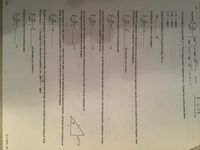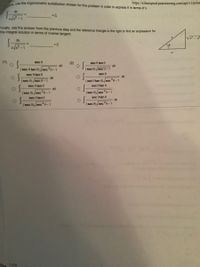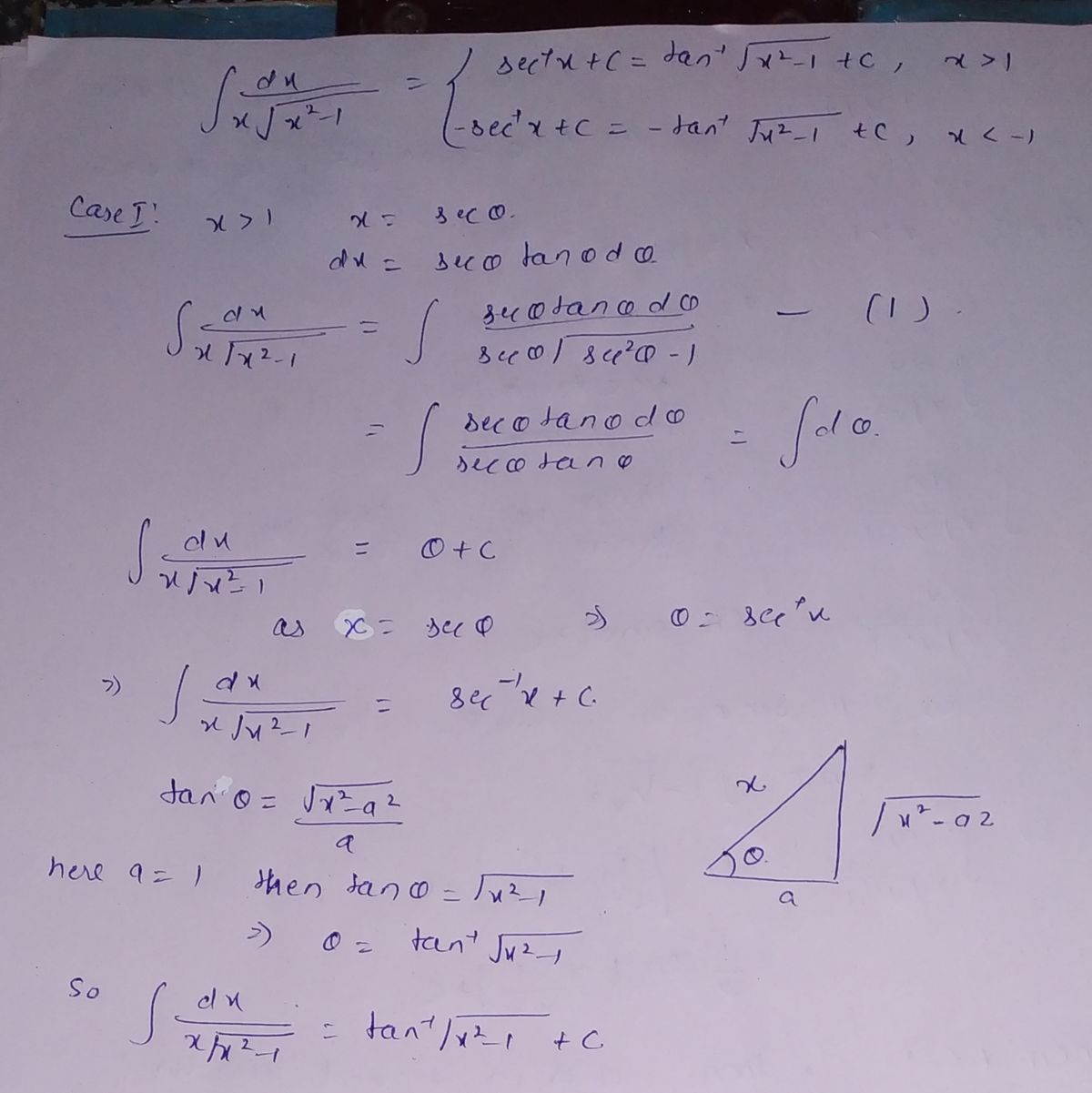
Calculus: Early Transcendentals
8th Edition
ISBN: 9781285741550
Author: James Stewart
Publisher: Cengage Learning
expand_more
expand_more
format_list_bulleted
Concept explainers
Topic Video
Question
Question 14

Transcribed Image Text:8.4.79
14
if x>1
secx+C = tan1x -1 +C
Show that
x/>
sec x+C= -tan -1+C if x< -1.
First consider the case where x> 1. Find a trigonometric substitution for x. Choose the correct answer below.
OA. x sec 0
O B. x sin 8
C. x-tan 0
Using the substitution from the previous step, find dx.
dx
Substitute forx and dx in the integral.
dx
= (1)
Rewnite the expression in the radical from the previous step using a trigonometric identity, and then simplify the entire integrand. Note
that because x> 1, the angle e is in the first quadrant.
de (Simplify your answer.)
Integrate the result from the previous step.
dx
+ C
The original indefinite integral is in terms of x, so the final answer must be also in terms of x. Use the trigonometric substitution chosen
for this problem to express 0 in terms of x.
+ C
Use the answer from the previous step and the reference triangle to the right to find an expression for
the integral solution in terms of inverse tangent.
V-
dx
+ C
a
Now consider the case where x< - 1. Note that in this case, 0 must be restricted to the second quadrant. Using the same procedure as
before, find a trigonometric substitution for x, find dx, and make the substitution into the integral.
dx
= (2)
1
Rewrite the expression in the radical from the previous step using a trigonometric identity, and then simplify the entire integrand. Note
that becausex< -1. the angle 8 is in the second quadrant, and tan 0 = - tan 0
de (Simplify your answer.)
Integrate the result from the previous step.
+ C
of 8
2/17/2021, 20:

Transcribed Image Text:Use the trigonometric substitution chosen for this problem in order to express 0 in terms of x.
https://xlitemprod.pearsoncmg.com/api/v1/print
dx
+C
Finally, use the answer from the previous step and the reference triangle to the right to find an expression for
the integral solution in terms of inverse tangent.
V-a
dx
+C
(1)
sec e
(2)
sec 0 tan 0
de
de
sec 0 tan 0)sec 0-1
(sec 0)/sec 0-1
sec 0 tan e
sec 0
d0
de
(sec 0 tan 0)-/sec 20-1
sec 0 tan 0
(sec 0) sec 0-1
sec 0 tan e
de
(sec 0)/sec e-1
(sec 0)-/sec 20- 1
sec 0 tan 0
sec 0 tan 0
de
(sec 0)/sec 2e-1
(sec 0)-/sec20-1
7 of 8
Expert Solution
arrow_forward
Step 1

Trending nowThis is a popular solution!
Step by stepSolved in 2 steps with 2 images

Knowledge Booster
Learn more about
Need a deep-dive on the concept behind this application? Look no further. Learn more about this topic, calculus and related others by exploring similar questions and additional content below.Similar questions
Recommended textbooks for you
 Calculus: Early TranscendentalsCalculusISBN:9781285741550Author:James StewartPublisher:Cengage Learning
Calculus: Early TranscendentalsCalculusISBN:9781285741550Author:James StewartPublisher:Cengage Learning Thomas' Calculus (14th Edition)CalculusISBN:9780134438986Author:Joel R. Hass, Christopher E. Heil, Maurice D. WeirPublisher:PEARSON
Thomas' Calculus (14th Edition)CalculusISBN:9780134438986Author:Joel R. Hass, Christopher E. Heil, Maurice D. WeirPublisher:PEARSON Calculus: Early Transcendentals (3rd Edition)CalculusISBN:9780134763644Author:William L. Briggs, Lyle Cochran, Bernard Gillett, Eric SchulzPublisher:PEARSON
Calculus: Early Transcendentals (3rd Edition)CalculusISBN:9780134763644Author:William L. Briggs, Lyle Cochran, Bernard Gillett, Eric SchulzPublisher:PEARSON Calculus: Early TranscendentalsCalculusISBN:9781319050740Author:Jon Rogawski, Colin Adams, Robert FranzosaPublisher:W. H. Freeman
Calculus: Early TranscendentalsCalculusISBN:9781319050740Author:Jon Rogawski, Colin Adams, Robert FranzosaPublisher:W. H. Freeman
 Calculus: Early Transcendental FunctionsCalculusISBN:9781337552516Author:Ron Larson, Bruce H. EdwardsPublisher:Cengage Learning
Calculus: Early Transcendental FunctionsCalculusISBN:9781337552516Author:Ron Larson, Bruce H. EdwardsPublisher:Cengage Learning

Calculus: Early Transcendentals
Calculus
ISBN:9781285741550
Author:James Stewart
Publisher:Cengage Learning

Thomas' Calculus (14th Edition)
Calculus
ISBN:9780134438986
Author:Joel R. Hass, Christopher E. Heil, Maurice D. Weir
Publisher:PEARSON

Calculus: Early Transcendentals (3rd Edition)
Calculus
ISBN:9780134763644
Author:William L. Briggs, Lyle Cochran, Bernard Gillett, Eric Schulz
Publisher:PEARSON

Calculus: Early Transcendentals
Calculus
ISBN:9781319050740
Author:Jon Rogawski, Colin Adams, Robert Franzosa
Publisher:W. H. Freeman


Calculus: Early Transcendental Functions
Calculus
ISBN:9781337552516
Author:Ron Larson, Bruce H. Edwards
Publisher:Cengage Learning